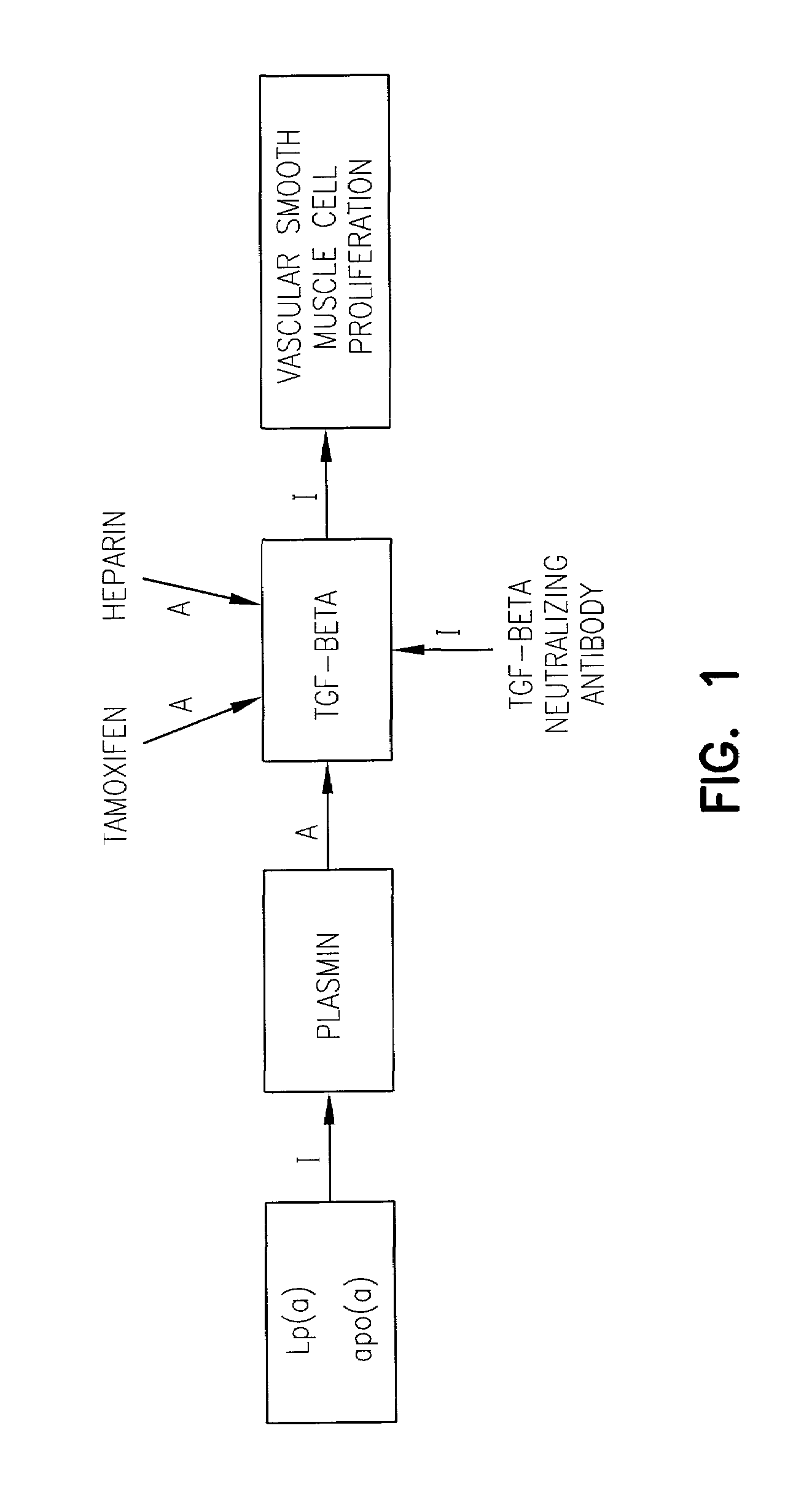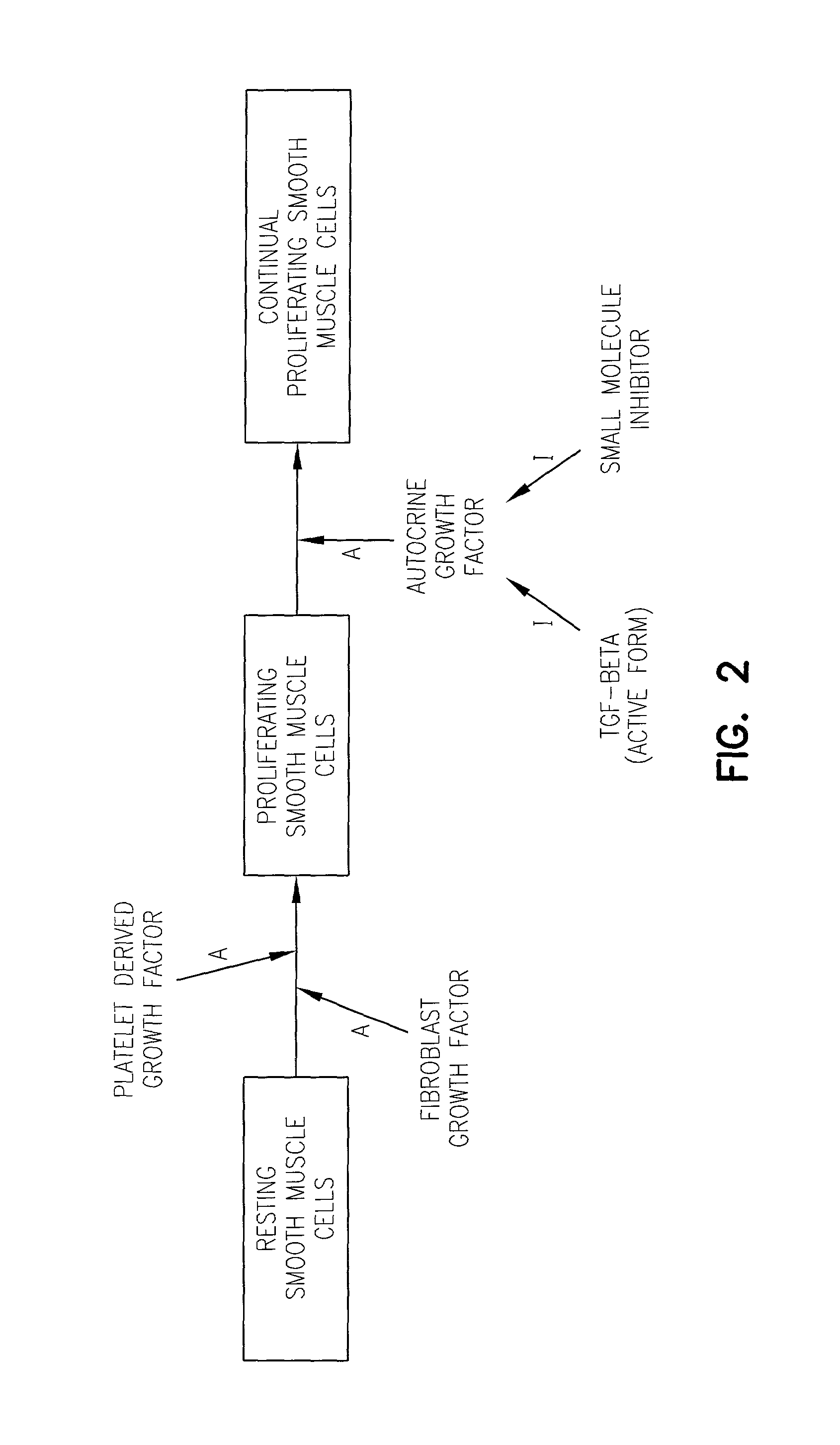Method to determine TGF-beta
a technology of tgf and beta, applied in the field of cardiovascular pathologies, can solve the problems of significant morbidity and mortality, no surgical intervention or post-surgical treatment (to date) has proven effective in preventing restenosis, and the stenosis following ptca remains a significant problem, etc., to achieve the effect of inhibiting lipid accumulation, reducing lumen diameter, and reducing morbidity and mortality
- Summary
- Abstract
- Description
- Claims
- Application Information
AI Technical Summary
Benefits of technology
Problems solved by technology
Method used
Image
Examples
example 1
Impact of Tamoxifen on Vascular Smooth Muscle Cells and the Relationship thereof to TGF-Beta Production and Activation
[0149]Cell culture, DNA synthesis assay and cell counting. Rat vascular smooth muscle cells were cultured after enzymatic dispersion of the aortic media from 12–17 week old Wistar rats as described in Grainger et al., Biochem. J., 277: 145–151, 1991. When the cells reached confluence (after about 6 days) the cells were released with trypsin / EDTA (available from Gibco) and diluted 1:2 in Dulbecco's modification of Eagle's medium (DMEM; available from ICN / Flow) supplemented with 100 U / ml penicillin and 10% fetal calf serum (FCS). The cells were then replated on tissue culture plastic (available from ICN / Flow) at approximately 1×104 cells / cm2. The cells were subcultured repeatedly in this way when confluence was attained (about every 4 days), and the cells were used between passages 6 and 12.
[0150]Rat adventitial fibroblasts were cultured as described in Grainger et al....
example 2
Heparin Effect on VSMC Proliferation and Differentiation
[0166]Heparins. An unfractionated, high molecular weight, anticoagulant pig mucosal heparin, fragments of heparin devoid of anticoagulant activity, and fragments of heparin with anticoagulant activity were tested. In addition, heparin coupled to agarose beads (Sigma Chemical Co., St. Louis, Mo.) was examined (see also Grainger et al., Cardiovascular Res. 27:2238–47, 1993).
[0167]Effect on proliferation. Freshly dispersed rat VSMC, prepared as in Example 1, were cultured in medium containing serum (as in Example 1) in the presence or absence of heparin. The cells were counted at intervals. Depending on the heparin used, the increase in cell number at 144 hours (when control cells enter stationary phase) was reduced by between 27±4.2% and 76±3.2% (p<0.0005 compared with cell number in control wells for all heparins tested). Although the effects of the heparins at 100 μg / ml were similar, there was a trend to greater effectiveness w...
example 3
Comparison of Enzyme-Dispersed and Explant-Derived Human VSMC
[0173]Materials. Collagenase (C-0130), elastase (E-0258), anti-rabbit IgG peroxidase-conjugated antibody, the chromogenic substrate orthophenylenediamine, and streptomycin sulfate were obtained from Sigma. Tamoxifen (free base) was purchased from Aldrich. Dulbecco's modified Eagle's Medium (D-MEM) and medium M199 were purchased from Flow Laboratories. 6-[3H]-thymidine and the cell proliferation kit were obtained from Amersham International. Anti-TGF-beta antibodies (BDA19 and BDA47) were purchased from R&D Systems. EGF, PDGF-AA and PDGF-BB were obtained from Bachem, and were dissolved in filter-sterilized 25 mM Tris-HCl, pH 7.5, containing 1% fatty acid-free bovine serum albumin (BSA). Basic fibroblast growth factor and insulin-like growth factor 1 (N-mer) were obtained from Bachem and dissolved in sterile MilliQ water. Antiotensin II and endothelin 1 were obtained from Sigma and dissolved in sterile MilliQ water. TGF-beta...
PUM
| Property | Measurement | Unit |
|---|---|---|
| time period | aaaaa | aaaaa |
| doubling time | aaaaa | aaaaa |
| population doubling time | aaaaa | aaaaa |
Abstract
Description
Claims
Application Information
 Login to View More
Login to View More - R&D
- Intellectual Property
- Life Sciences
- Materials
- Tech Scout
- Unparalleled Data Quality
- Higher Quality Content
- 60% Fewer Hallucinations
Browse by: Latest US Patents, China's latest patents, Technical Efficacy Thesaurus, Application Domain, Technology Topic, Popular Technical Reports.
© 2025 PatSnap. All rights reserved.Legal|Privacy policy|Modern Slavery Act Transparency Statement|Sitemap|About US| Contact US: help@patsnap.com



